Mechanical Properties of SMA/PVA-ECC under Uniaxial Tensile Loading
Abstract
:1. Introduction
2. Experimental Design
2.1. Material Properties
2.1.1. Engineered Cementitious Composites (ECC)
2.1.2. Shape Memory Alloys
2.2. SMA/PVA-ECC Specimen Design and Production
2.2.1. Specimen Design
2.2.2. Specimen Production
2.3. Test Loading Scheme
3. Results and Discussion
3.1. Failure Behavior
3.2. Stress–Strain Curve
3.2.1. Comparative Analysis of ECC and SMA/PVA-ECC Specimens
3.2.2. Factors Affecting SMA/PVA-ECC Specimens
- SMA fiber content
- SMA fiber diameter
3.3. Analysis of Test Characteristic Parameters
3.4. SMA Fiber Strain Analysis
3.5. Tensile Constitutive Model
4. Conclusions
- (1)
- The knotted SMA fibers exhibit good anchoring performance with ECC, as well as good superelastic characteristics. After unloading, the micro-cracks in the SMA/PVA-ECC specimens are effectively closed, and the residual width of the main crack is significantly reduced.
- (2)
- The stress–strain curve of SMA/PVA-ECC exhibits a three-stage development process and obvious strain-hardening characteristics. The addition of SMA fibers improves the initial cracking strength and some ultimate strength of the composite specimens. After reaching the peak stress, the stress degradation of SMA/PVA-ECC is slower than that of ECC specimens, but most of the ultimate strains are lower than that of ECC.
- (3)
- The diameter and content of SMA fibers have a significant effect on the tensile properties of SMA/PVA-ECC. The smaller the diameter and content of the fiber, the better the tensile performance of the specimen. When the content of large-diameter fibers is moderate, the tensile performance of the specimen is the best. At low content, the tensile performance of small-diameter fiber specimens is better, and when exceeding a certain content, the tensile performance of medium-diameter fiber specimens is the best. Among them, the specimen with a fiber diameter of 0.2 mm and a content of 0.2% has the best comprehensive tensile performance, with an increase in initial cracking strength, ultimate strength, and strain of 56.4%, 23.6% and 13.4%, respectively, compared with ECC specimens.
- (4)
- The bilinear hardening model used in this study can well reflect the tensile stress–strain relationship of SMAF-ECC composite materials.
Author Contributions
Funding
Data Availability Statement
Conflicts of Interest
References
- Pakravan, H.R.; Jamshidi, M.; Latifi, M. The effect of hybridization and geometry of polypropylene fibers on engineered cementitious composites reinforced by polyvinyl alcohol fibers. J. Compos. Mater. 2016, 50, 1007–1020. [Google Scholar] [CrossRef]
- Arce, G.A.; Noorvand, H.; Hassan, M.M.; Rupnow, T.; Dhakal, N. Feasibility of low fiber content PVA-ECC for jointless pavement application. Constr. Build. Mater. 2021, 268, 121131. [Google Scholar] [CrossRef]
- Arce, G.; Noorvand, H.; Hassan, M.; Rupnow, T.; Hungria, R. Cost-effective ECC with low fiber content for pavement application. In MATEC Web of Conferences; EDP Sciences: Les Ulis, France, 2019; Volume 271, p. 07001. [Google Scholar]
- Feng, Z.; Zhou, Y.; Sui, L.; Zhu, Z. Optimal design of a low-cost high-performance hybrid fiber engineered cementitious composites. Constr. Build. Mater. 2022, 345, 128372. [Google Scholar] [CrossRef]
- Dehghani, A.; Aslani, F. Crack recovery and re-centring performance of cementitious composites with pseudoelastic shape memory alloy fibres. Constr. Build. Mater. 2021, 298, 123888. [Google Scholar] [CrossRef]
- Andrawes, B.; DesRoches, R. Unseating prevention for multiple frame bridges using superelastic devices. Smart Mater. Struct. 2005, 14, S60. [Google Scholar] [CrossRef]
- Fang, C.; Wang, W. Shape Memory Alloys for Seismic Resilience; Springer: Singapore, 2020. [Google Scholar]
- Dizaji, F.S.; Dizaji, M.S. Seismic performance assessment of steel frames upgraded with shape memory alloy re-centering dampers for passive protection of structures subjected to seismic excitations using high-performance NiTiHfPd material. Smart Mater. Struct. 2022, 31, 065004. [Google Scholar] [CrossRef]
- Zhou, X.; Ke, K.; Yam, M.C.; Zhao, Q.; Huang, Y.; Di, J. Shape memory alloy plates: Cyclic tension-release performance, seismic applications in beam-to-column connections and a structural seismic demand perspective. Thin-Walled Struct. 2021, 167, 108158. [Google Scholar] [CrossRef]
- Li, X.; Li, M.; Song, G. Energy-dissipating and self-repairing SMA-ECC composite material system. Smart Mater. Struct. 2015, 24, 025024. [Google Scholar] [CrossRef]
- Indhumathi, S.; Dinesh, A.; Pichumani, M. Diverse perspectives on self healing ability of Engineered Cement Composite–All-inclusive insight. Constr. Build. Mater. 2022, 323, 126473. [Google Scholar]
- Ali, M.A.E.M.; Soliman, A.M.; Nehdi, M.L. Hybrid-fiber reinforced engineered cementitious composite under tensile and impact loading. Mater. Des. 2017, 117, 139–149. [Google Scholar] [CrossRef]
- Ali, M.A.; Nehdi, M.L. Experimental investigation on mechanical properties of shape memory alloy fibre-reinforced ECC composite. In Proceedings of the 11th International Conference on Civil and Architecture Engineering, Military Technical College, Cairo, Egypt, 19–21 April 2016; Volume 11, pp. 1–11. [Google Scholar]
- Khakimova, E.; Sherif, M.M.; Ozbulut, O.E.; Harris, D.K.; Ozyildirim, H.C. Experimental investigations on shape memory alloy fiber reinforced concrete. In Proceedings of the 6th International Conference on Advances in Experimental Structural Engineering, 11th International Workshop on Advanced Smart Materials and Smart Structures Technology, University of Illinois, Urbana-Champaign, Champaign, IL, USA, 1–2 August 2015. [Google Scholar]
- Sherif, M.M.; Khakimova, E.M.; Tanks, J.; Ozbulut, O.E. Cyclic flexural behavior of hybrid SMA/steel fiber reinforced concrete analyzed by optical and acoustic techniques. Compos. Struct. 2018, 201, 248–260. [Google Scholar] [CrossRef]
- Yang, Z.; Deng, T.; Li, J.; Xu, C. Experimental Study on Self-Centering Performance of the SMA Fiber Reinforced ECC Composite Beam. Materials 2022, 15, 3062. [Google Scholar] [CrossRef] [PubMed]
- Yang, Z.; Du, Y.; Liang, Y.; Ke, X. Mechanical Behavior of Shape Memory Alloy Fibers Embedded in Engineered Cementitious Composite Matrix under Cyclic Pullout Loads. Materials 2022, 15, 4531. [Google Scholar] [CrossRef] [PubMed]
- Ma, R.; Guo, L.; Ye, S.; Sun, W.; Liu, J. Influence of hybrid fiber reinforcement on mechanical properties and autogenous shrinkage of an ecological UHPFRCC. J. Mater. Civ. Eng. 2019, 31, 04019032. [Google Scholar] [CrossRef]
- Meng, W.; Khayat, K.H. Effect of hybrid fibers on fresh properties, mechanical properties, and autogenous shrinkage of cost-effective UHPC. J. Mater. Civ. Eng. 2018, 30, 04018030. [Google Scholar] [CrossRef]
- JC/T2461-2018; Standard Test Method for the Mechanical Properties of Ductile Fiber Reinforced Cementitious Composites. China Building Industry Press: Beijing, China, 2018.
- Fathi, H.; Shokrieh, M.M.; Saeedi, A. Effect of tensile loading rate on interfacial properties of SMA/polymer composites. Compos. Part B Eng. 2020, 183, 107730. [Google Scholar] [CrossRef]
- Liu, H.; Zhang, Q.; Gu, C.; Su, H.; Li, V. Influence of microcrack self-healing behavior on the permeability of Engineered Cementitious Composites. Cem. Concr. Compos. 2017, 82, 14–22. [Google Scholar] [CrossRef]
- Kanda, T.; Lin, Z.; Li, V.C. Tensile stress-strain modeling of pseudostrain hardening cementitious composites. J. Mater. Civ. Eng. 2000, 12, 147–156. [Google Scholar] [CrossRef]
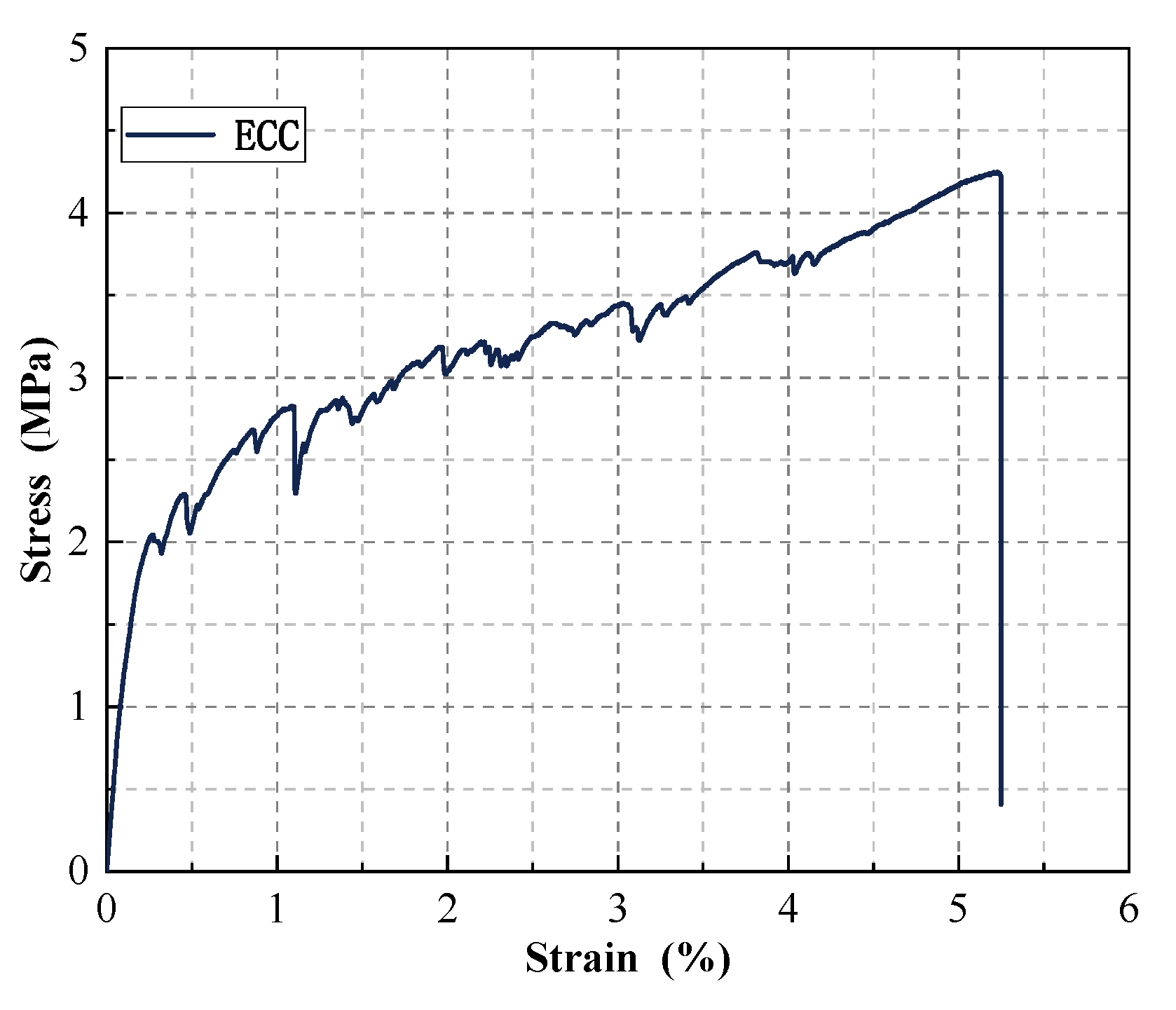
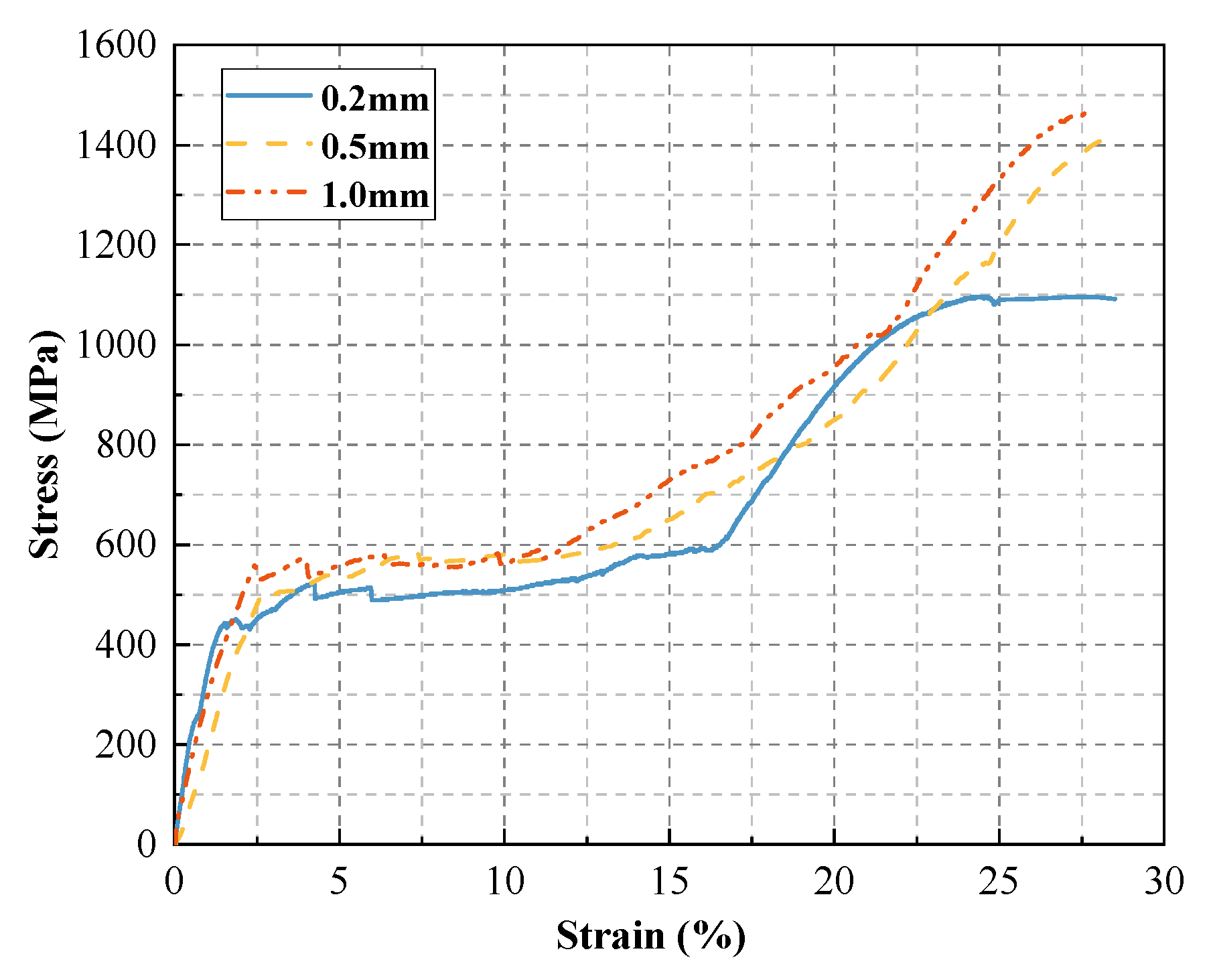
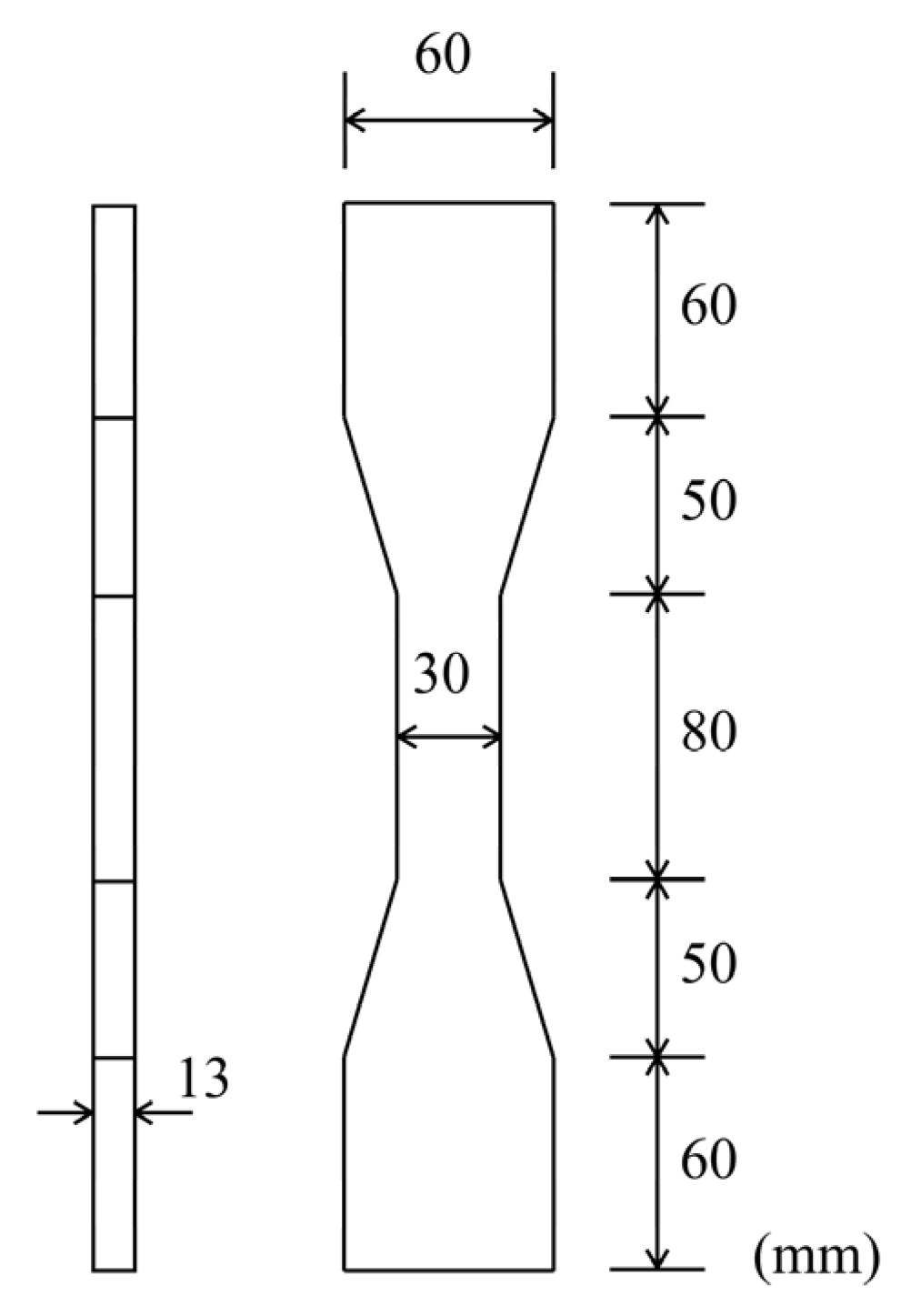
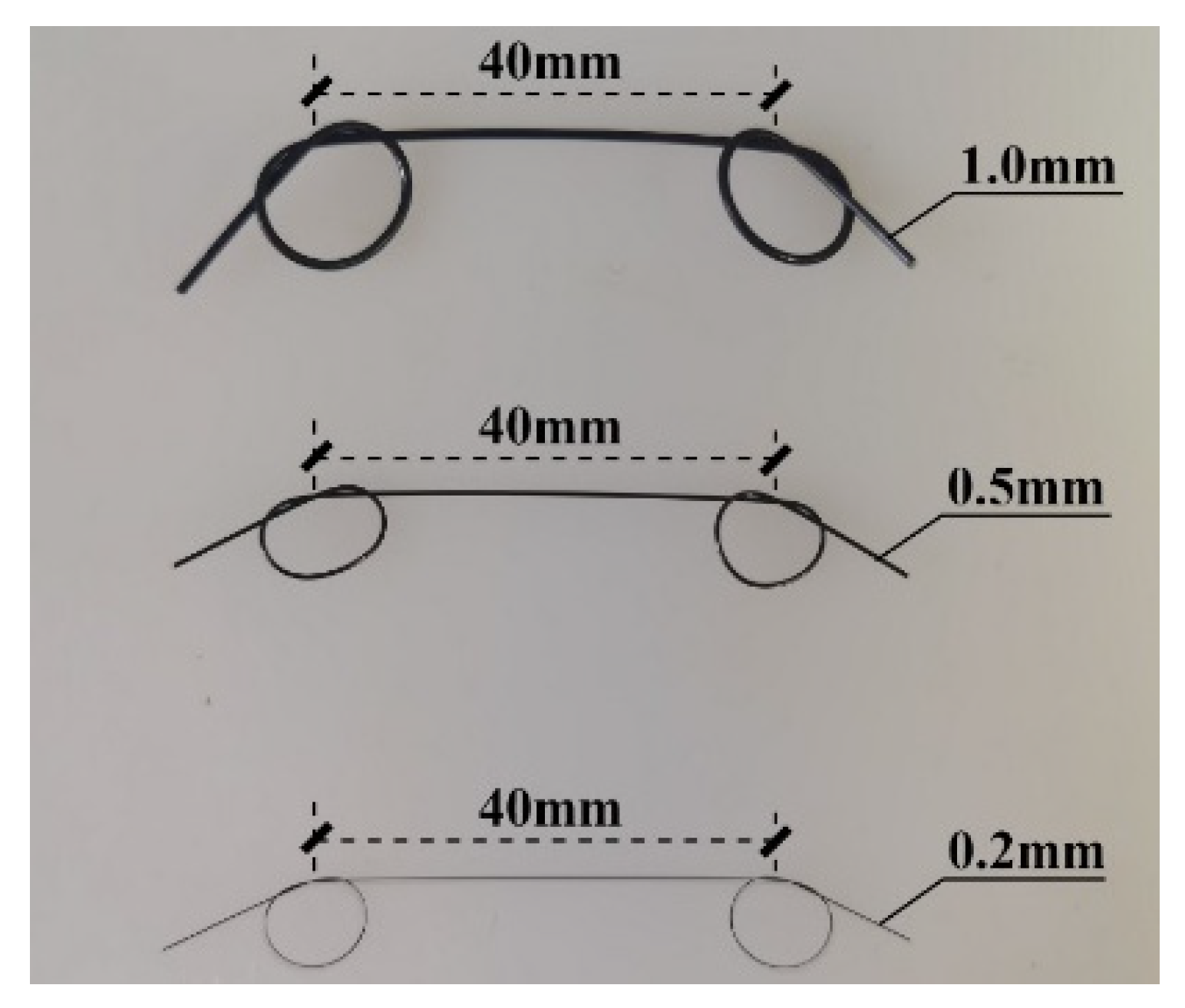

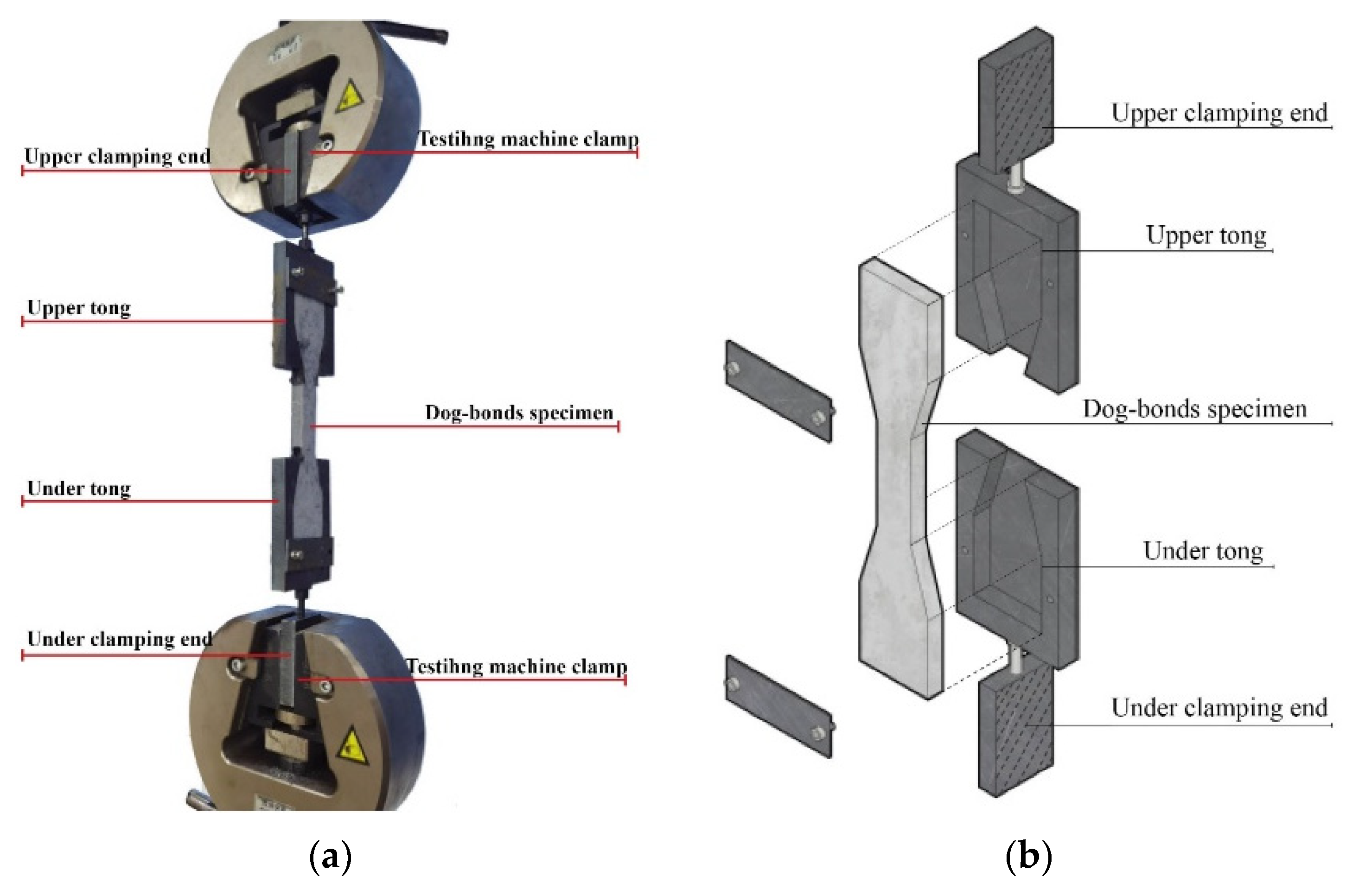
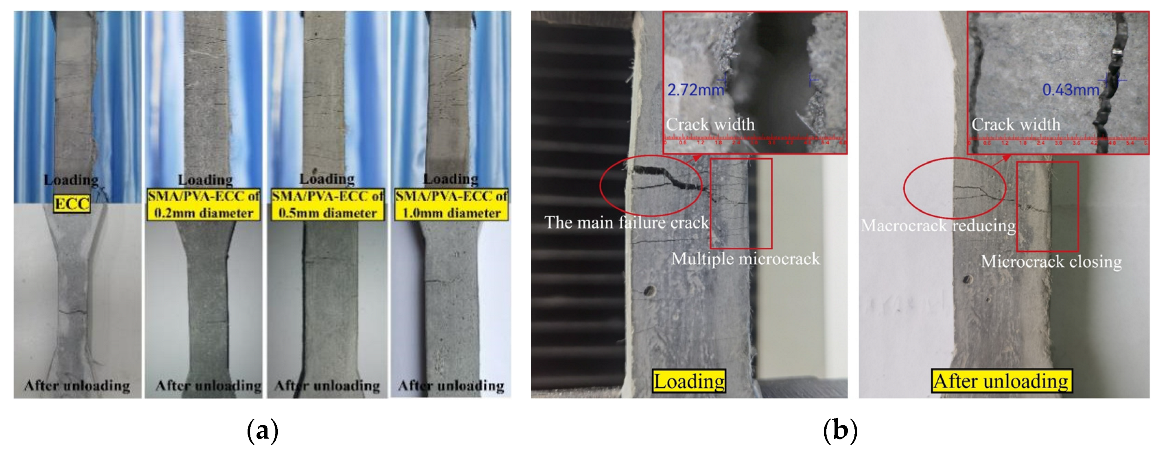
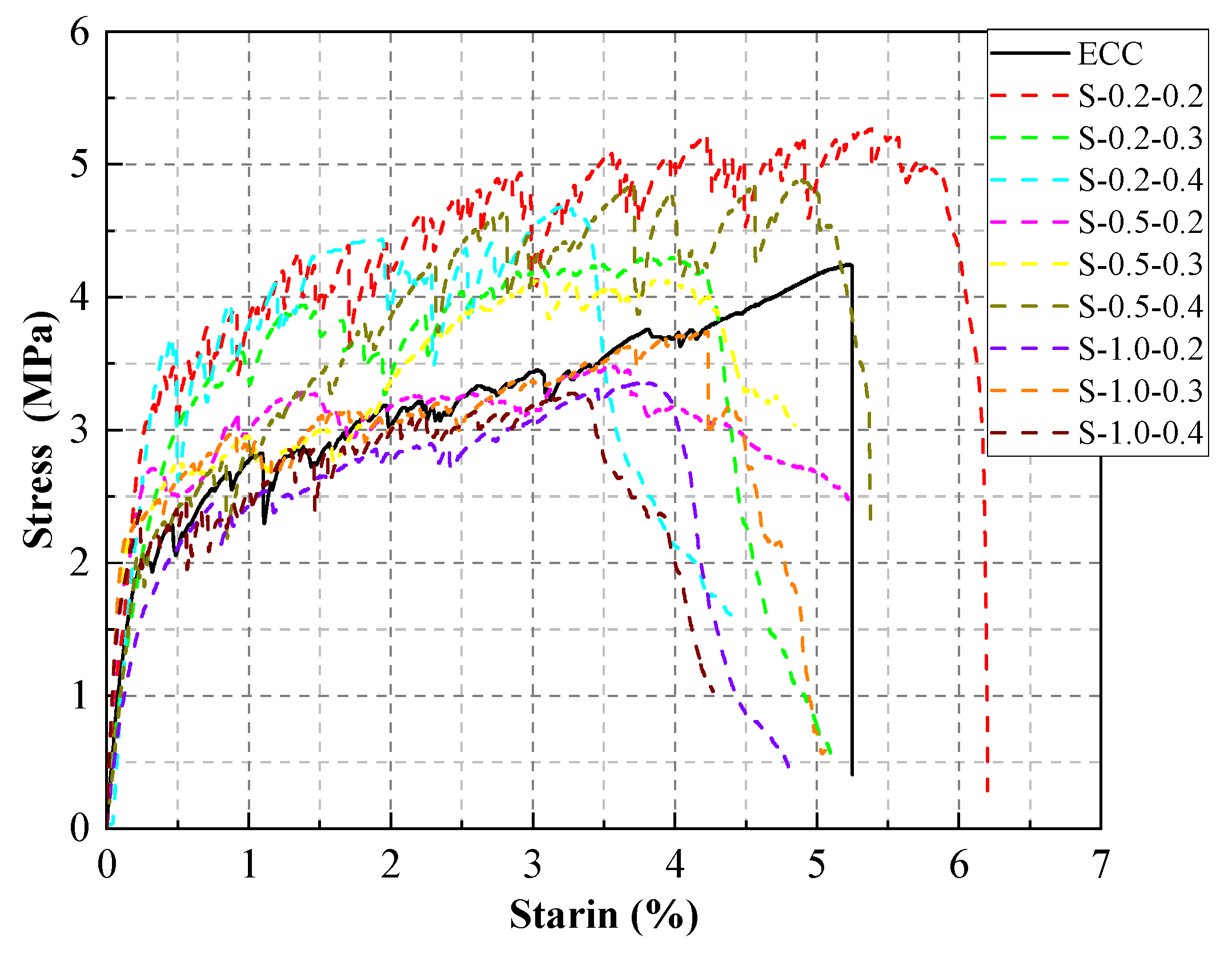



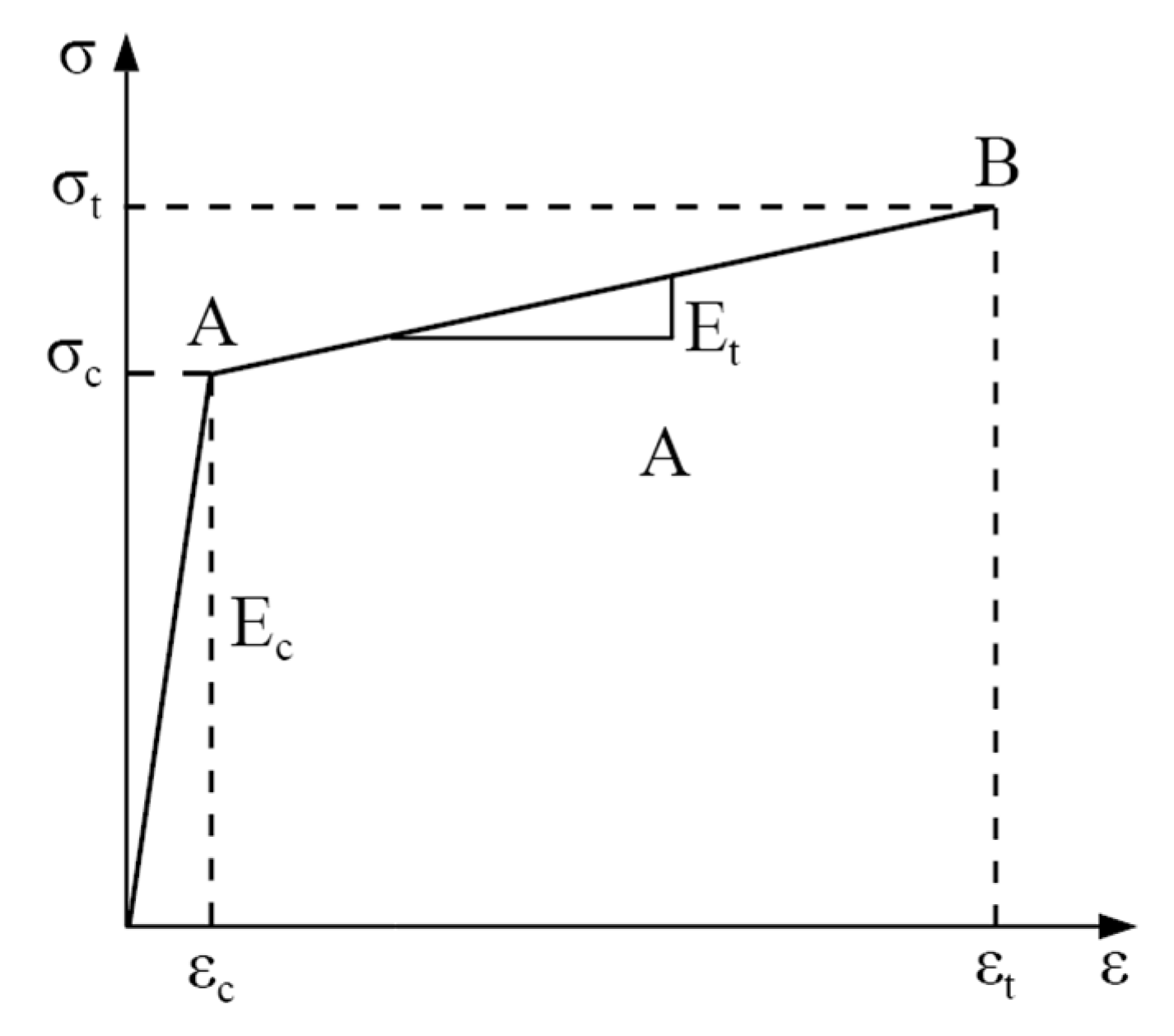

| Raw Material | Cement | Fly Ash | Silica Sand | Water | Water Reducer | PVA/% |
|---|---|---|---|---|---|---|
| Mix proportion | 1.0 | 4.0 | 0.20 | 0.22 | 0.0079 | 2% * |
| Specimen Number | SMA Diameter/mm | SMA Volume Content/% | PVA Volume Content/% | Number of Specimens |
|---|---|---|---|---|
| ECC | - | - | 2 | 3 |
| S-0.2-0.2 | 0.2 | 2 | 3 | |
| S-0.2-0.3 | 0.2 | 0.3 | 2 | 3 |
| S-0.2-0.4 | 0.4 | 2 | 3 | |
| S-0.5-0.2 | 0.2 | 2 | 3 | |
| S-0.5-0.3 | 0.5 | 0.3 | 2 | 3 |
| S-0.5-0.4 | 0.4 | 2 | 3 | |
| S-1.0-0.2 | 0.2 | 2 | 3 | |
| S-1.0-0.3 | 1.0 | 0.3 | 2 | 3 |
| S-1.0-0.4 | 0.4 | 2 | 3 |
| Specimen Number | Main Crack Width/mm | Residual Crack Width/mm |
|---|---|---|
| S-0.2-0.2 | 2.44 | 0.34 |
| S-0.5-0.2 | 2.72 | 0.43 |
| S-1.0-0.2 | 3.14 | 0.47 |
| Number | Cracking Strength/MPa | Cracking Strain/% | Tensile Strength/MPa | Tensile Strain/% |
|---|---|---|---|---|
| ECC | 2.04 | 0.26 | 4.24 | 5.23 |
| S-0.2-0.2 | 3.19 | 0.33 | 5.24 | 5.93 |
| S-0.2-0.3 | 3.15 | 0.56 | 4.30 | 4.01 |
| S-0.2-0.4 | 3.57 | 0.48 | 4.68 | 3.83 |
| S-0.5-0.2 | 2.71 | 0.32 | 3.43 | 3.56 |
| S-0.5-0.3 | 2.35 | 0.23 | 4.09 | 4.10 |
| S-0.5-0.4 | 2.05 | 0.21 | 4.88 | 4.89 |
| S-1.0-0.2 | 2.07 | 0.47 | 3.36 | 3.83 |
| S-1.0-0.3 | 2.23 | 0.14 | 3.81 | 4.32 |
| S-1.0-0.4 | 2.39 | 0.23 | 3.31 | 3.91 |
| Specimen Number | Main Crack Width/mm | Strain of SMA Fiber/% |
|---|---|---|
| S-0.2-0.2 (0.3, 0.4) | 2.44 | 6.1% |
| S-0.5-0.2 (0.3, 0.4) | 2.72 | 6.8% |
| S-1.0-0.2 (0.3, 0.4) | 3.14 | 7.9% |
Disclaimer/Publisher’s Note: The statements, opinions and data contained in all publications are solely those of the individual author(s) and contributor(s) and not of MDPI and/or the editor(s). MDPI and/or the editor(s) disclaim responsibility for any injury to people or property resulting from any ideas, methods, instructions or products referred to in the content. |
© 2023 by the authors. Licensee MDPI, Basel, Switzerland. This article is an open access article distributed under the terms and conditions of the Creative Commons Attribution (CC BY) license (https://creativecommons.org/licenses/by/4.0/).
Share and Cite
Yang, Z.; Li, J.; Zhong, Y.; Qi, X. Mechanical Properties of SMA/PVA-ECC under Uniaxial Tensile Loading. Buildings 2023, 13, 2116. https://doi.org/10.3390/buildings13082116
Yang Z, Li J, Zhong Y, Qi X. Mechanical Properties of SMA/PVA-ECC under Uniaxial Tensile Loading. Buildings. 2023; 13(8):2116. https://doi.org/10.3390/buildings13082116
Chicago/Turabian StyleYang, Zhao, Jiankun Li, Yilan Zhong, and Xiaolong Qi. 2023. "Mechanical Properties of SMA/PVA-ECC under Uniaxial Tensile Loading" Buildings 13, no. 8: 2116. https://doi.org/10.3390/buildings13082116
APA StyleYang, Z., Li, J., Zhong, Y., & Qi, X. (2023). Mechanical Properties of SMA/PVA-ECC under Uniaxial Tensile Loading. Buildings, 13(8), 2116. https://doi.org/10.3390/buildings13082116






